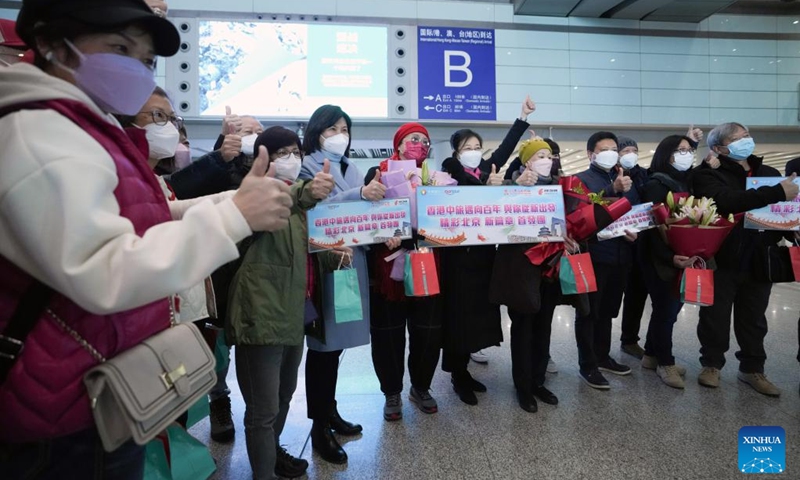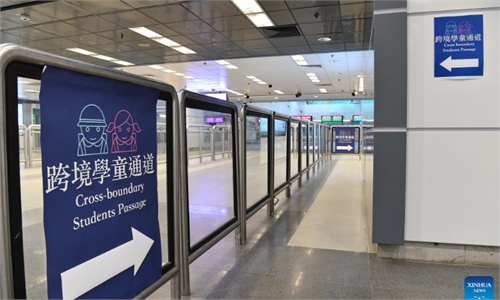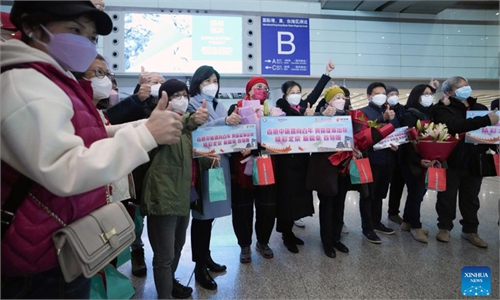Airlines welcome re-launch outbound group tours, recovery of international travel expected

Tourists of the first tour group from Hong Kong pose for a group photo at Beijing Capital International Airport in Beijing, capital of China, Feb. 6, 2023. The Chinese mainland fully resumed normal travel with the Hong Kong and Macao special administrative regions (SARs) starting Monday, in what is expected to be a strong boost for the two regions' economic development.(Photo: Xinhua)
The re-launch of outbound group tours has triggered growing international resumption of outbound travel, which has brought more hope for a quick recovery of the industry that has suffered three years of bleeding due to the pandemic
China Southern Airlines, the largest carrier in China in terms of fleet size, welcomed the first outbound tour group after a three-year suspension, the carrier told the Global Times on Tuesday.
The group has about 20 passengers and it flew from Guangzhou to Bangkok, Thailand on Monday.
China Southern said in the next two days, it will also welcome a number of tourist groups heading to Dubai, Jakarta and Phnom Penh, flying from Guangzhou. Routes to Southeast Asian countries are favored by passengers.
China Southern said that will continue to increase its international capacity, and resume and open 48 round-trip routes to 12 destinations. As of Monday, it had operated a total of 50 international and regional routes, with a weekly flight total of 82.
China Southern is not alone.
China Eastern Airlines said that its international and regional flights and those of its subsidiaries will return to 60, and reach 410 flights per week as of February 28. The resumed routes will mainly be to Southeast Asia, Hong Kong, Macao and Taiwan.
As of Monday, the carrier and its subsidiaries had 52 outbound passenger routes, up to 302 flights per week.
The resumption of overseas routes came after recent measures, including the borders between Hong Kong and the Chinese mainland reopening fully after three years on Monday.
Domestic travel agencies also resumed outbound group tours to 20 countries and regions on a trial basis from Monday. Companies could release and launch products and promotions or make other preparations as of the same day.
The Civil Aviation Administration of China said late in December that it would lift COVID-19 travel restrictions from January 8, prompting many carriers to restore international passenger services.
The number of people leaving or entering the mainland reached 676,000 on Monday, the most since the COVID-19 pandemic began. Among them, those who traveled cross-border between the Chinese mainland and Hong Kong or Macao reached 568,000, or 84 percent of the total, data from the National Immigration Administration showed on Tuesday.
A total of 220,000 people left Hong Kong via land ports on Monday, the first day after the borders fully reopened between Hong Kong and the mainland, according to the Hong Kong Special Administrative Region government.
However, market insiders took a cautious attitude toward the profits of the aviation industry, citing lower airfares.
Data from travel platform qunar.com showed that, as of Tuesday, a ticket from Hong Kong to Singapore on February 14 cost 670 yuan ($98.8). The fare was 563 yuan from Hong Kong to Manila and 662 yuan from Guangzhou to Manila.
Industry information provider Flight Master said the average ticket price had dropped by about 8 percent from the previous week since February, a decline of 31 percent year-on-year.
The major income source for airlines is business class, instead of package tours, an anonymous insider told the Global Times on Tuesday.
China's "big three" state-owned airlines recently estimated losses of more than 100 billion yuan for 2022, around 1.5 times higher than in 2021, as a result of the pandemic, high fuel prices and depreciation of the yuan.



